-
Call Us
+91 964-375-5133
-
Email Us
ieffnepal@gmail.com
-
VENUE
KATHMANDU
- Signin Group Info
NEPAL TOURISM
Welcome to Kathmandu, Capital City of Nepal
NEPAL
Nepal-The democratic republic is a landlocked country in South Asia. It is mainly situated in the Himalayas, but also includes parts of the Indo-Gangetic Plain, bordering Tibet of China to the north, and India in the south, east, and west, while it is narrowly separated from Bangladesh. .
Nepal has a diverse geography, including fertile plains, subalpine forested hills, and eight of the world's ten tallest mountains, including Mount Everest, the highest point on Earth.
Nepal is indeed a mountaineer’s dream. The ‘Land of Sherpas’ is often recognised by its iconic peak — Mt. Everest — and its snowy landscapes, ancient traditions and vibrant culture. Blessed with favourable climatic conditions and diverse topography, tourist places in Nepal are visually charming and picturesque.
The Himalayan beauty to be yet another adventure destination, for Nepal is dotted with several monasteries and is renowned as a sacred pilgrimage site for people around the world which marked as one of the best tourist places in Nepal. Whether you’re taking a casual stroll within Kathmandu, Bhaktapur or Patan, be prepared to stumble across quaint Buddhist monasteries and century old stupas. Unshaken by the natural calamity that hit the country a while ago, Nepal still holds the crown of a cultural powerhouse. Exploring the tiny kingdom will acquaint you to some top-notch palaces, age-old shrines and intricate temple art at every nook and corner. Nepal is also home to the great Everest Base Camp Trek, which is every trekker's dream
City of Kathmandu to visit sacred and historic attractions,and then head out to some of the best places outside of the capital are Chitwan National Park for wildlife viewing, and the lakeside town of Pokhara, a popular area for embarking on treks., others are intrigued by the culture and the famous and yet others come hoping to find some sort of spiritual awakening. Nepal can be an adrenaline adventure, a cultural eye opener, a life-changing experience, or all of the above.
Trekkers will find a variety of options across Nepal, with the most important areas being the Everest, Annapurna, and Langtang regions.
Nepal is a multinational state, with Nepali as the official language. Kathmandu is the nation's capital and the largest city.
Kathmandu - Nepal's Capital City
Kathmandu is the capital and largest city of Nepal. The city is located in the northwestern part of Kathmandu Valley, at an elevation of approximately 4,500 feet. The Kathmandu district itself is known as the "city of temples," attracting Hindu people and those who have interest in others’ religion. The Kathmandu Valley, which covers an area of 218 square miles, has been declared a World Heritage Site consisting of seven different monument zones.
These zones are: The city centers of, Kathmandu, Patan, and Bhaktapur, the two most important Buddhist stupas, Swayambhunath and Boudhanath, and two famous Hindu shrines, Pashupatinath temple and Changu Narayan.The Bagmati, Bishnumati, Dhobikhola, and Tukucha rivers wind through the city.
The city has become the country’s most important business and commercial centre through the efforts of its Newar merchant families.
Kathmandu's Culture at a Glance
Founded in a vast valley after draining a large lake, legends abound in this remarkable city and every street has a shrine or two. Kathmandu is an incredibly diverse, historic city with amazing architecture, exquisite wood carvings and metal craft which showcase the skills of the Newar artisans of centuries ago.
Despite the fast life of a metropolis, its people remain refreshingly friendly towards visitors. Retaining its ancient traditions, Kathmandu is blessed by the Living Goddess Kumari, a little Buddhist girl who represents the powerful Hindu Goddess Taleju. City life is enriched by endless ceremonial processions and events that take to the streets every now and then, with throngs of devotees seeking joy in spiritual celebrations.
Tribhuvan International Airport welcomes you with great delight and honor however, for you to be able to make your vacation comfortable and memorable.
ITINERARY : KATHMANDU MONUMENTS TOUR
DAY-1 : KATHMANDU
|
Monuments with Entry fee:
• Kathmandu Durbar Square: 1000 NPRs • Boudhanath Stupa: 250 NPRs • Pashupatinath Temple: 1000NPRs • Langtang National Park: 3000 NPRs • Hanuman dhoka: 1000 NPRs • Bauddha Stupa: 400 NPRs • Swayambhu Stupa: 200 NPRs • Garden of Dreams: 400 NPRs • Bhaktapur Durbar Square : 1500 NPRs • Changunarayan Temple :300 NPRs
• The participant has to follow the dress code while taking entry in to some of the sacred temples. (Proper dressing with head cover).
Places to Visit in Kathmandu with short Descriptions:
BOUDHANATH STUPA
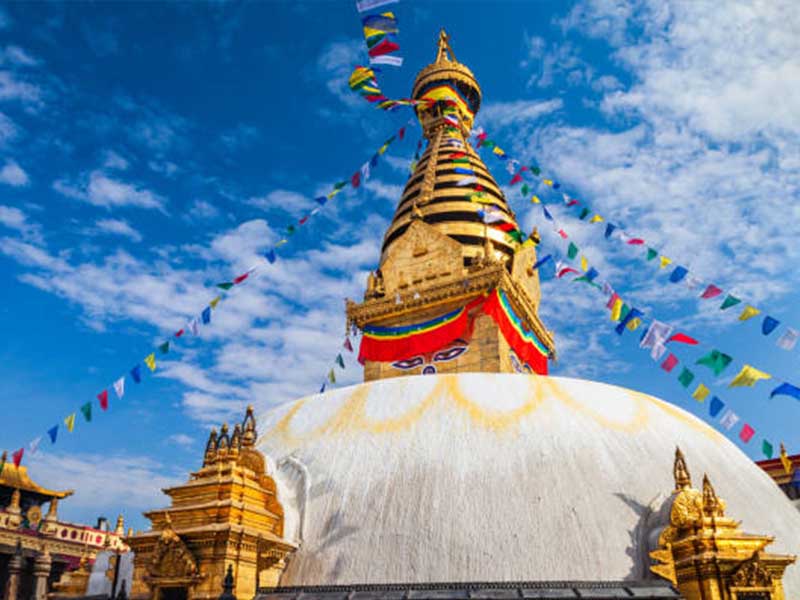
Boudha is a stupa in Kathmandu, Nepal. Located about 11 km from the center and northeastern outskirts of Kathmandu, its massive mandala makes it one of the largest spherical stupas in Nepal and the world. Boudha Stupa is a UNESCO World Heritage Site.
Boudhanath Stupa, with its colossal white mandala set against the beautiful landscape of the Himalayas, is the most important Buddhist stupa in Nepal. The original construction is as old as 600 AD. The Tibetan king Songtsen Gampo is said to have constructed it as homage to Avalokiteshvara, back when he had converted to Buddhism. Another story goes that the king constructed the stupa in penance after he mistakenly killed his father.
Later during the 14th century, Boudhanath stupa in Kathmandu was plundered and left in a state of ruins by Mughal invaders. So the current edifice that stands is a reconstruction by later rulers. However, the significance of the place remains untarnished. At night when the place comes alive with lights streaming down from the spire, Boudhanath Stupa looks magical.
The most important thing about Boudhanath stupa is the many architectural and numerological tributes it pays to Buddhism. From a bird’s eye view, the map of Boudha Kathmandu looks like Mount Meru – the mythical mountain at the centre of the cosmos as per Buddhism.
Four meditating Buddha statues guard the four cardinal points of the temple. From the base to the top, there are five different segments that signify each of the five elements of nature. The plinth at the bottom represents earth, upon which the temple is built. The magnificent white-washed dome is water that sustains life.
Above that is a small square base where there are eyes drawn on all. The Boudhanath stupa eyes are said to be Lord Buddha’s watching over the world. On top of that goes up a spire with 13 steps. The triangular shape of the spire represents fire. The 13 steps are to mark the 13 rites of passage to attain enlightenment as said by Buddha. Above the spire, the gilded canopy spread like an umbrella is the embodiment of air and finally the gilded spire; rising above all is what represents the ether, or void or the eternal space.
DURBAR SQUARE

Out of the three Durbar Squares of Kathmandu Valley, the one in Kathmandu is the most visited one in terms of tourists. Kathmandu Durbar Square and the other two at Bhaktapur and Patan are three of the seven UNESCO World Heritage sites located in Kathmandu Valley. The Durbar square once served as the courtyard for the royal palace. The kings of the valley used to be coronated here years after years.
ll the different festivities and celebrations held under the king’s rule were also celebrated here. In a sense, Durbar squares of Nepal are the bearers of the age-old legacy that the country has witnessed and experienced. This one is no different.
The courtyard of Kathmandu Durbar Square bears specimens of authentic Newari architecture and dozens of temples catering to both Hindu and Buddhist faith. The original construction of the quadrangle goes back to the 3rd century during the Licchavi reign. It has seen several reconstructions afterwards under the rule of Mallas, Shahs and Gorkhas.
The entire Durbar square is made of three separate but linked quadrangles. Towards the south is the Basantapur Square which was formerly the royal elephant stable and now an area for souvenir shopping. The main Durbar is towards the west. In the northeast is the entrance courtyard known as Hanuman Dhoka.
This is where the royal palace stands. The Mallas and the Shahs ruled over from this place. There is a stone image of Lord Hanuman in the entryway, which gives this square the name. The rooms inside the royal palace can be visited to have a glimpse of the royal Nepalese lifestyle.
The palace also houses two museums – King Tribhuvan museum and the Mahendra Museum that displays artefacts, coins, weapons, instruments and other items the royal family used back in the day.
SWAYAMBHUNATH TEMPLE
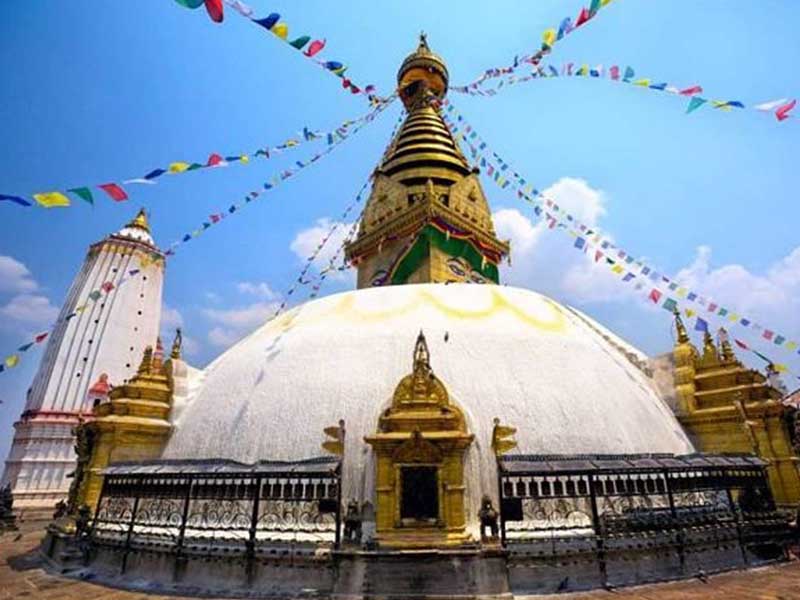
Swayambhunath Temple in Kathmandu is also popularly known as the ‘Monkey Temple’ as there are many monkeys around the temple. It is situated northwest of the Kathmandu Valley and sits at the top of a hill, offering a beautiful panoramic view of the entire Kathmandu city to the visitors. The place is embraced with peace and prayers, and one can attain harmony here. Kathmandu city’s glory started from this point.
The place is famous for the inner peace and harmony which the visitors obtain when they pay a visit to this place. Swayambhunath Temple is considered to be one of the holiest Buddhist Chaityas in Nepal. This stupa is one of the oldest temples in Nepal and has many shrines and monasteries present inside.
Swayambhu in the English language means "self-existent one". It has a steep pathway of stone steps leading up to the shrine. Swayambhunath Temple, Kathmandu Nepal is among the must-visit places in Kathmandu city and witnesses large footfall throughout the year. The Tibetan name of the place means “Sublime Trees” due to the presence of a variety of trees at the hilltop.
Swayambhunath Temple, Kathmandu Nepal was built by King Manadeva and was later developed into a centre of Buddhism by the 13th century. According to some sayings, it is believed that the Swayambhunath Temple evolved on its own during the creation of the valley, out of a primordial lake dating back to more than 2000 years ago.
Legends believe that Swayambhunath Temple was evolved from a lotus flower which blooms at the centre of a lake which was spread across the Kathmandu Valley. A huge image of the Sakyamuni Buddha in Nepal is present on the western boundary pedestal of the temple. A temple of Manjusri or Saraswati - the Goddess of Learning is situated behind the hilltop. The base is covered with prayer wheels. Devotees move around the temple all day.
Major attractions which can be witnessed in the Swayambhunath Temple, Kathmandu is the large gold-plated Vajra ‘thunderbolt’ which has been placed on the east side of the stupa. The Sakyamuni Buddha statue and the Sleeping Buddha statue is a delightful site.
The Dewa Dharma Monastery is famous for the bronze statue of Buddha, and the place also has many traditional Tibetan paintings. The Swayambhunath Temple is dedicated to The Goddess of all children, Harati. This temple is very beautiful with enchanting arrangement amidst nature and placed on a hilltop.
PASHUPATINATH TEMPLE
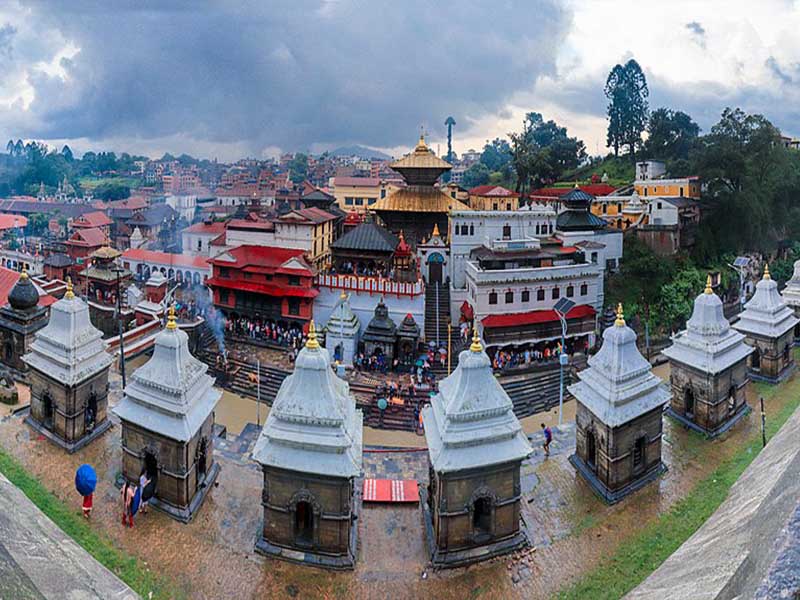
Pashupatinath Temple, located on the banks of Bagmati River, is one of the most important shrines of Shiva – not only in Nepal but in the entire world. This is the abode of Nepal’s national deity, Pashupatinath manifestation of Lord Shiva, where he is the father of all living beings in the cosmos. This is not a single monument but a sprawling collection of temples, shrines, ashrams and occasional rock inscriptions – all packed together into one complex.
The main temple which houses Lord Pashupatinath Mandir in Nepal has a pagoda style gilded roof, sides covered in silver and the rest of it made of well-carved wood. The sacred Shiva lingam resides inside, guarded by his faithful servant Nandi Bull. Shiva’s consort Goddess Sati has her own temple called Guheshwori.
This is one of those temple precincts where cremations happen inside the premises. By the holy River Bagmati, Hindu people perform the final rituals for their deceased. Pashupatinath Temple is one of the 7 UNESCO World Heritage sites of Kathmandu Valley. It is said that the 12 Jyotirlingas of India make up the body of Lord Shiva, while Pashupatinath Temple in Nepal is the head. One cannot help but feel mesmerised by an expanse of the temple complex and the spiritual atmosphere that hovers over the place.
Like every Hindu temple, Pashupatinath Nepal too has its own share of history and legends. Recorded history says that the temple as it stands today was constructed by Lichhavi King Shupushpa in the 5th century after the old temple was ruined by termites. Over the years, multiple new shrines were added, including a Vishnu and Rama temple. But the actual origin is lost in myths and legends.
Some believe the Shiva lingam of Pashupatinath Kathmandu was self-manifested. Other believe that Lord Shiva himself descended upon the valley in the form of an animal and he liked this place so much that he blessed it with his ‘Lord of all animals’ form.
KATHMANDU VALLEY
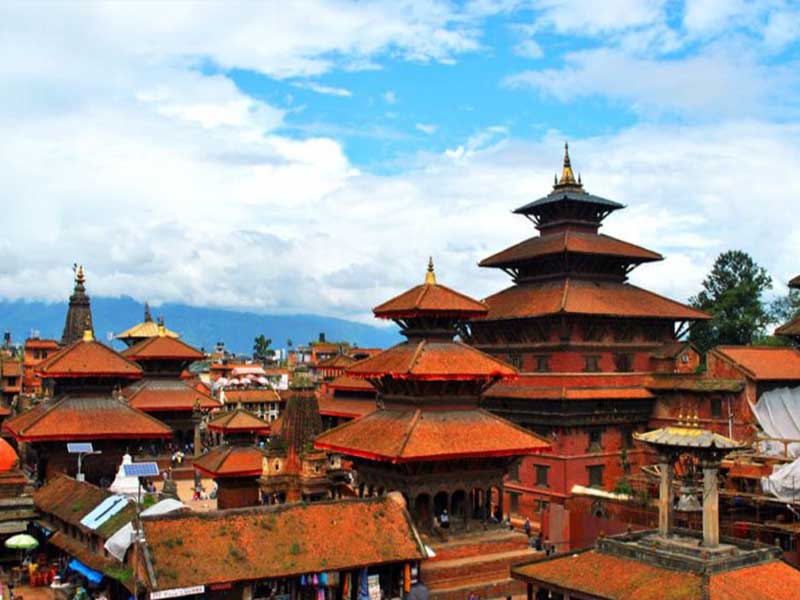
Kathmandu Valley is the heartbeat of Nepal and one of the most visited destinations all along the Himalayas. Located at the momentous crossroads of all the ancient civilizations of Asia, Kathmandu Valley has always been the silent spectator of the regimes that rose and fell in China over the head and India down below. But it had its own share of history as well.
History of Kathmandu Valley starts with the native residents, the Newars. One can find a reminiscence of Newari architecture, culture, traditions and cuisines all around their Kathmandu Valley tour. Afterwards, it changed hands a few times, but mostly between the Mallas and the Gorkhas. The latter was responsible for unifying Nepal and creating a modern state.
Kathmandu valley of Nepal is by far the most eventful place in the country. Everything worth mentioning takes place around here. All the best places to visit in Nepal are also in this valley. To give an idea, this place itself has seven UNESCO World Heritage sites, all of which are very popular for Kathmandu Valley sightseeing.
The Seven UNESCO World Heritage sites:
The holy and sacred Shiva shrine, Pashupatinath Temple is situated on the banks of River Bagmati and is only 3 km away from the airport. Changu Narayan, dedicated to Lord Vishnu, is the other heritage site among the temples of Kathmandu Valley. Swayambhunath Stupa and Boudha Stupa represent Buddhism in the list. The remaining three places are taken up by the Durbar Squares.
Durbar squares are the city centre locations of Nepalese cities, where most of the urban thoroughfares meet, and points of interests are located. Kathmandu, Bhaktapur and Patan Durbar Squares are three really impressive locations to explore.
There are dozens of other temples and shrines of both Buddhist and Hindu faiths, scattered all around the districts in Kathmandu Valley for one to explore. For the adventurers at heart, there are short trails for Kathmandu Valley trekking to places like Nagarkot, Dhulikhel or Namo Buddha
KOPAN MONASTERY
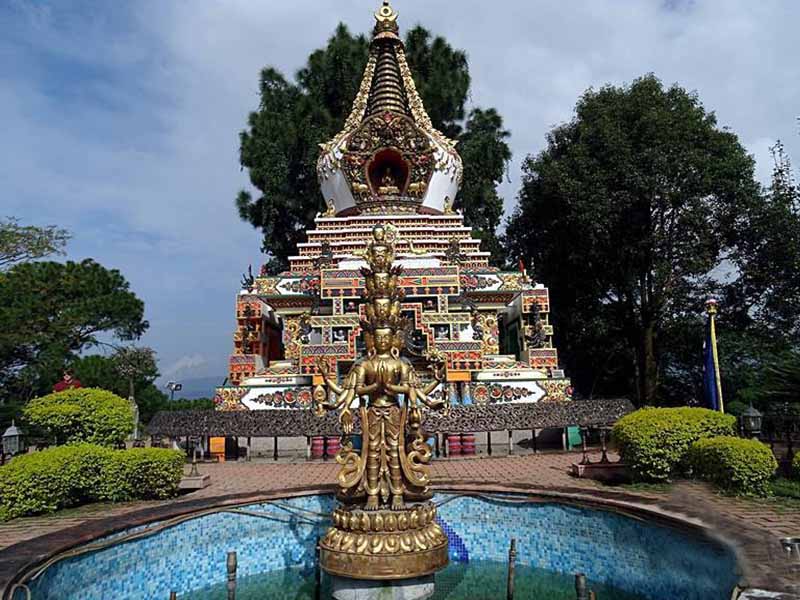
Kopan Monastery is an educational and spiritual institution, located on the outskirts of Kathmandu city near the Boudhanath Stupa in the valley region. Although it looks quite antique, its foundation was laid only in the last century. Lamas Thubten Yeshe and Thubten Zopa Rinpoche bought the land on which Kopan Monastery stands from Nepal’s royal astrologer and set up this institution.
Kopan Monastery in Kathmandu is a member of the Foundation for the Preservation of the Mahayana Tradition, or in short FPMT. It is an international network of dharma centres based on Gelugpa faith, introduced into Tibetan Buddhism by Je Tsongkhapa in the late 14th century. Kopan Monastery once used to be the headquarters for FPMT.
Now it is a nunnery, a study centre and a monastic shrine which draws a crowd considerably. Kopan Monastery Kathmandu Nepal has become quite a popular destination for foreigners, who are looking for a spiritual retreat and want to explore the famous Oriental faith of mystique lands of Tibet.
FPMT students can stay here and explore the depths of Buddhism with the help of the different courses and retreats available. ‘Discover Buddhism’ is the all year-long course, while ‘The Next Step’ is a more in-depth, intense study of the religion and Kopan Monastery meditation. There is a daily 90-min Dharma talk session scheduled from Monday to Friday at 10:30 am.
The Group and Private Kopan Monastery Retreat options are preferred by many for a peaceful week, delving deep into their own consciousness. The courses here are taught mostly based on the traditional Lam Rim – the holy text of Tibetan Buddhism showing the path towards enlightenment as told by Buddha. The texts are accompanied by informal conversations and guided meditation.
CHANDRAGIRI
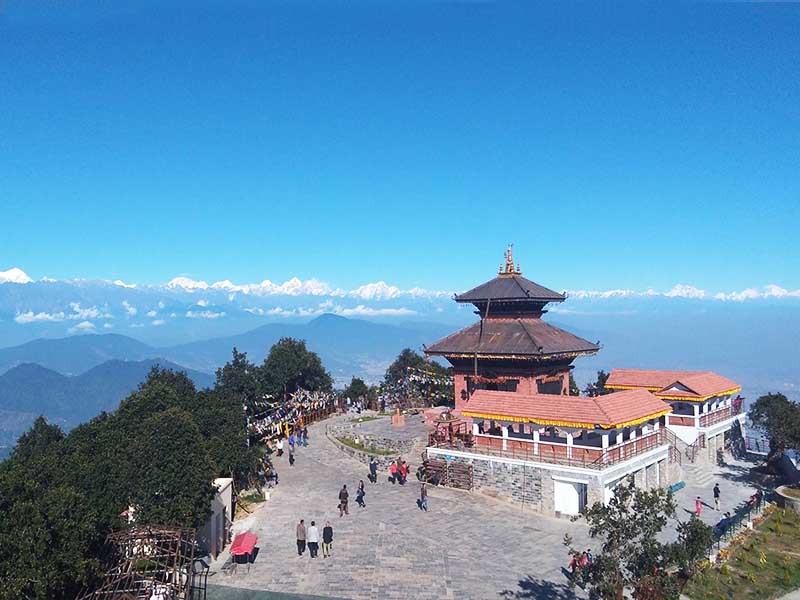
Less than an hour’s drive away from Kathmandu city, Chandragiri hilltop is a mesmerising tourist location, enriched with equal amounts of natural beauty and cultural significance. The view of the entire Kathmandu valley can be seen from up there. It is said to be so beautiful that when King Ranjit Malla had to leave his kingdom defeated, he took one last glance at it from here and broke down into tears.
The great Gorkhali king Prithvi Narayan Shah also decided to annexe the valley after seeing it from Chandragiri hills. At 2500 km on the top of Chandragiri Nepal, the entire stretch of all the great Himalayan mountain massifs can be seen. For an even better glimpse, there is a view tower with binoculars.
From west to east runs the great Annapurna, Nepal’s favourite trekking destination Mount Manaslu, the mighty Ganesh Himal and then the magnificent Langtang Himal. With a clear sky, one might even catch a glimpse of Mount Everest.
Cable Car Ride:
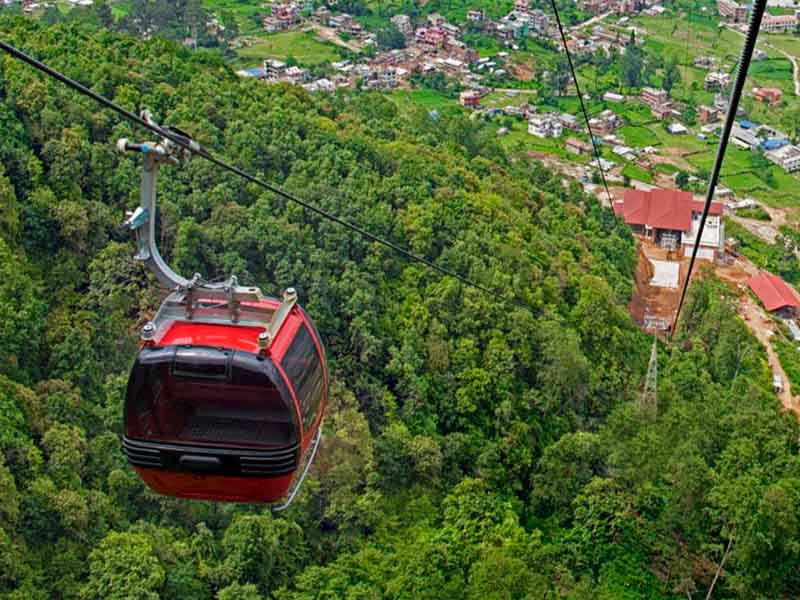
One of the main attractions here is the cable ride up the slope. From the foot of the hill, the Chandragiri cable cars take tourists up to the top smoothly. The spectacular 360°C view of the valley and the mountains are absolutely worth the money spent on the ticket. The journey is only of 10 minutes and covers an ascent of 2.5 km.
Bhaleshwar Mahadev Temple:
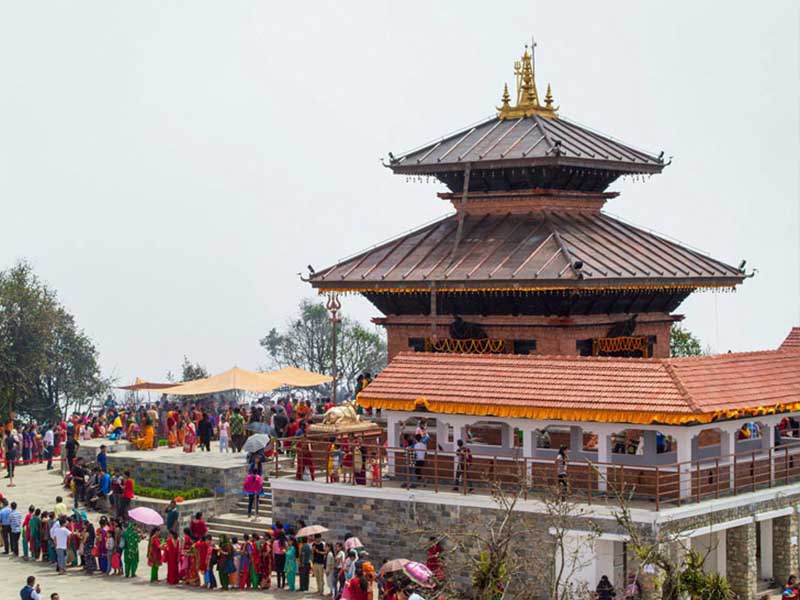
At the top of Chandragiri hill Nepal, the tourists are greeted with the Shiva shrine of Bhaleshwar Mahadev. This temple is said to have been built over goddess Sati’s forehead. It was part of a very important chapter in Hindu mythology when a bereaved Lord Shiva roamed all around the universe with his consort’s corpse in arms.
This temple atop Chandragiri Kathmandu boasts true Newari architecture with wooden carvings and an antique vibe. There is a statue of Prithvi Narayan Shah outside – the king Lord Shiva had blessed to win over the Valley of Kathmandu.
LANGTANG NATIONAL PARK

Langtang National Park in Nepal is one of the places still untouched and untarnished by all the urbanisation. Established in 1976, this protected area covers the districts of Nuwakot, Rasuwa and Sindhupalchok in Central Nepal Himalayas. Langtang National Park shares its northern and eastern borders with Qomolangma National Nature Preserve in Tibet China.
On the south lies Kathmandu Valley some 32 km away. On its west is Nepal’s largest water system – Trishuli and Koshi Rivers. The forest offers an extensive ecological biodiversity for a variety of flora and fauna to thrive in perfect harmony. Gosaikunda Lake and Dorje Lakpa range bisects the park from east to west and from south to east.
The beautiful view of the highest summit Langtang Lirung is something worth remembering. The flora here consists of typical upper tropical vegetation – firs, maples, pines, oaks and hemlocks are aplenty. Among fauna, red panda, Himalayan black bear, leopard and musk deer are native.
Trekking in Langtang National Park:
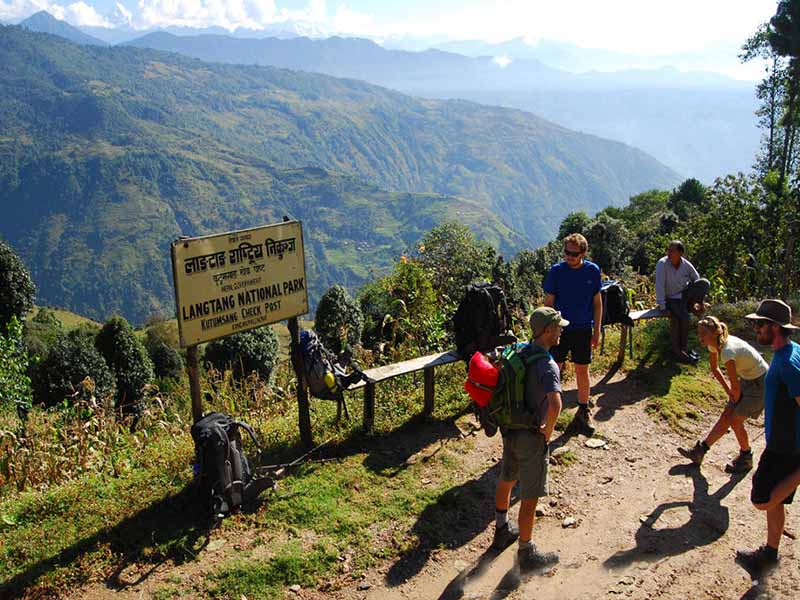
Langtang National Park is best explored on foot. Nothing quite matches the experience of taking in the beauty of the nature with every step. The main trek routes here are the Langtang Valley, Helambu and Gosaikunda Lake. The valley routes can be approached from Dhunche city. Ghoda Tabela lies midway to all the long distance hikes and there are many pandas here.
The villages of Langisha Yala and Tsero Ri also falls on the way. Gang La is the highest pass in Langtang National park trekking routes, mostly travelled by veteran hikers. Gosaikunda Lake via the picturesque Helambu village is perfect for an alternate route, lush with flowering plants and covered in high canopies.
For even remoter routes, one can venture to the Panch Pokhari region towards the east of Helambu, where there are five lakes clustered together or to the toe of Langshisa ice mass along the Gang La pass.
GARDEN OF DREAMS

The Garden of Dreams is located in the middle of the Kathmandu city, is a neoclassical garden with a rich history, considered to be peaceful covered with natural beauty amidst the crowded Kathmandu city. You can visit this place if you want to take some time out from your busy and hectic schedule and work life for obtaining inner peace. It is also known as Swapna Bagicha and is made up of renowned enclaves and pavilions.
The Garden of Dreams was created by late Field Marshal Kaiser Shumsher Rana in the early 1920s between the years of 1892-1964. The garden was created as a private garden of the creator and was regarded as a sophisticated garden. The exceptional design of the garden of dreams has drawn inspiration from the Edwardian style. The Garden of Dreams, Kathmandu is popular as the garden of Six Seasons of Nepal. It has a beautiful ensemble of fountains, pavilions and beautiful garden furniture.
There were six pavilions each of which was dedicated to six different seasons of Nepal. Also, the garden of dreams comprised urns, verandas, birdhouses and pergolas. The pavilions formed the architecture of the garden and displayed a cosmopolitan flavour to the neatly arranged trees, shrubs and flowers.
Kishore Narsingh, designed and guided the construction of the garden of dreams, a prominent architect who was well known for designing and constructing the Singha Durbar as well. After Kaiser Shumsher passed away, the garden remained in ruins for a long time and was recently renovated and restored in the year 2007.
The Garden of Dreams, Kathmandu has a lotus pond at the centre which creates a tranquil ambience full of trellises and pergolas, and the arrangements of all the blossoms form a shaded and fresh effect. The various trees, shrubs, plants and rare flowers create a wonderful and aromatic scene. The fountains and waterfall create a soft, noisy background amidst the hustle of the visitors.
The Garden of Dreams is also offered for various functions and occasions. The Garden of Dreams is covered with gorgeous details over the small garden and at the original entrance gate. A marble inscription from Omar Khayam’s Rubaiyat can also be witnessed here.
HANUMAN DHOKA

Hanuman Dhoka is situated in Durbar Square at the centre of Kathmandu city, Nepal. It is a complex of other structures such as the Royal Palace of the Malla kings and the Shah dynasty and covers an area of about five acres. Hanuman Dhoka Palace derived its name from the standing stone statue of Hanuman (Monkey God) which is present at the east side of the main entrance since 1672. ‘Dhoka’ means ‘door or gate’ in Nepali. The place witnesses huge number of footfall every day by tourists and local people.
The Hanuman Dhoka, Kathmandu, Nepal has great religious and historical importance. There is a sculpture of Lord Narasimha on the left who was the half-lion incarnation of Lord Vishnu. All these statues and sculptures are magnificent and overwhelming. The place is home to numerous monkeys. Hanuman’s image was used by the kings of the Malla dynasty on their battle flags. They place the Hanuman statue in the year 1672 at the entrance as a belief to keep evil spirits and the bad away.
A major attraction of Hanuman Dhoka, Kathmandu is the huge stone statue of Hanuman placed at the main entrance of the Durbar Square on the east. The statue is covered in red coloured clothes and is seen holding an umbrella. Also, The Hanuman Dhoka, Kathmandu Nepal is one of the finest examples of magnificent Newari architecture which you can witness here. The place is also very famous as a popular tourist attraction.
BUDHANILKANTHA TEMPLE
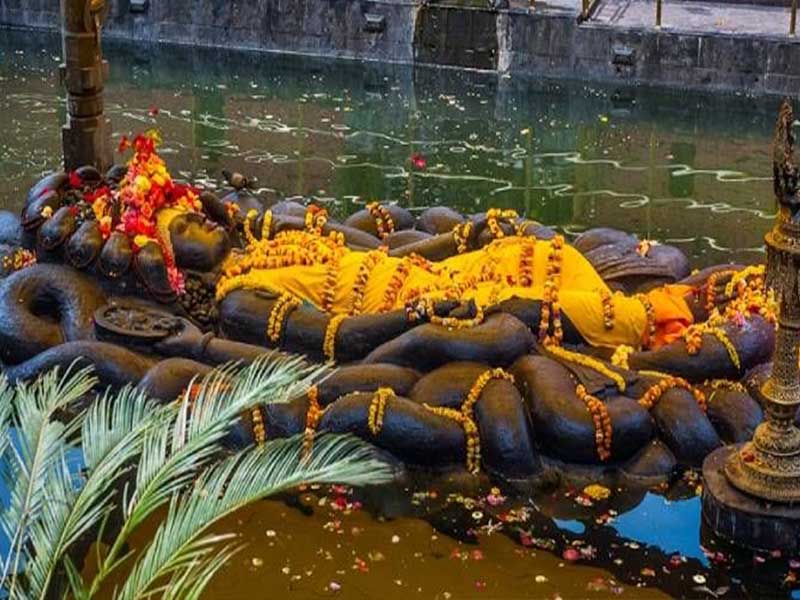
The Budhanilkantha Temple, Kathmandu portrays the statue of the Hindu God Vishnu. It is located approximately about 10 kilometres away from the Kathmandu city centre at the base of the Shivapuri Hill. The Budhanilkantha statue is the largest and most magnificent stone carving in entire Nepal. Budhanilkantha means “old blue-throat’. It is a peaceful temple in Kathmandu and is a must visit the place as well. Many tourists visit this temple every day.
History of the Budhanilkantha Temple, Kathmandu, Nepal has differing explanations. Origin of the Budhanilkantha statue has many stories behind it. Some believe that the statue had been sculpted and brought by forced labour or devotees to where it is presently in Kathmandu. It was brought here during the 7th century during Monarch Vishnugupta reign.
The Kathmandu valley at that time was under the control of Licchavi king Bhimarjun Dev. Some people are of the opinion that many years back a farmer and his wife struck the deity while cultivation and blood started to flow from the ground. This was how the lost statue of deity Budhanilkantha was found and recovered and then placed at the correct position. However, different people have different beliefs.
The Budhanilkantha Statue, Kathmandu is a major attraction as it has been carved out of a single black basalt stone block. The statue lies in a reclined position and is about 5 meters in length. The tank of water inside with the statue lies is about 13 meters in length. The Budhanilkantha Statue is also popularly known as the Sleeping Vishnu or Jalakshayan Narayan.
The statue of the deity portrays and depicts being reclined on the serpent Shesha, which forms twisted coils of itself. The statue has crossed legs, and Shesha considered to be a servant of Lord Vishnu forms a cradle for the Lord with its eleven heads. Vishnu’s four hands are seen holding objects symbolic of his divine powers. These include a chakra or disc which represents his mind, a conch shell representing the four elements, a lotus flower resembles the moving universe and the club is believed to portray primaeval knowledge.
THAMEL
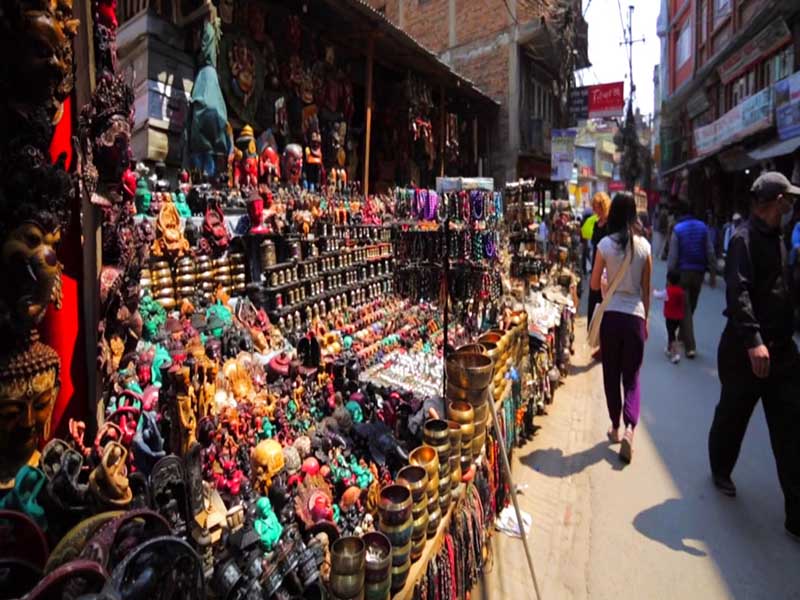
Thamel is the hotspot for tourists in Kathmandu. Thamel neighbourhood first became popular during the 1970-80s when hippie culture took over Kathmandu. Unconventional travellers, living out of their backpacks came in the Nepalese capital in hordes, and they all made Thamel their resident hub while in the city. Over the decades, Thamel Kathmandu turned into a bustling centre for shopping, eating or simply strolling around.
In 2017, Thamel was declared as a vehicle-free area to get rid of the honking and make the place a safer one for pedestrians. There are around 5-6 main streets in Thamel Nepal, and dozens of other veins and arteries stretching out in different directions. In these streets, one can expect to find literally anything and everything under the roof.
Shopping:
Thamel bazaar is by far the busiest place in Kathmandu on any given day (or night). From exotic bakeries and confectioners to trekking gears, from small curio and handicraft shops to garment and bookstores, from travel agencies to bars and restaurants of all types – shopping in Thamel is nothing short of a small event in itself. Bookstores are a big thing in Thamel. Paradise Bookshop is a vintage one, which trades old books for new ones and has a good collection. For shopping trekking equipment, one can visit North Face Store or the Tibetan-owned Sonam Trekking Store.
Night Life:
Thamel nightlife is something to look forward to the most in Kathmandu. After the day’s sightseeing and afternoon’s shopping sessions are over, the tourists in Kathmandu head towards the various bars, clubs and casinos in Thamel. Rum Doodle is an iconic place that has been visited by every Everest climber ever, starting with Edmund Hillary himself.
It is like visiting a shrine for the Mountaineers. Sam’s Bar is another favourite. Funky Buddha and Tome and Jerry’s are great choices too for live music.Another thing to do in Thamel is natural therapy. There are multiple Thamel massage parlours, spas and salons which cater to tourists for a quick foot massage or a complete back massage to fight jet-lags.
KASTHAMANDAP
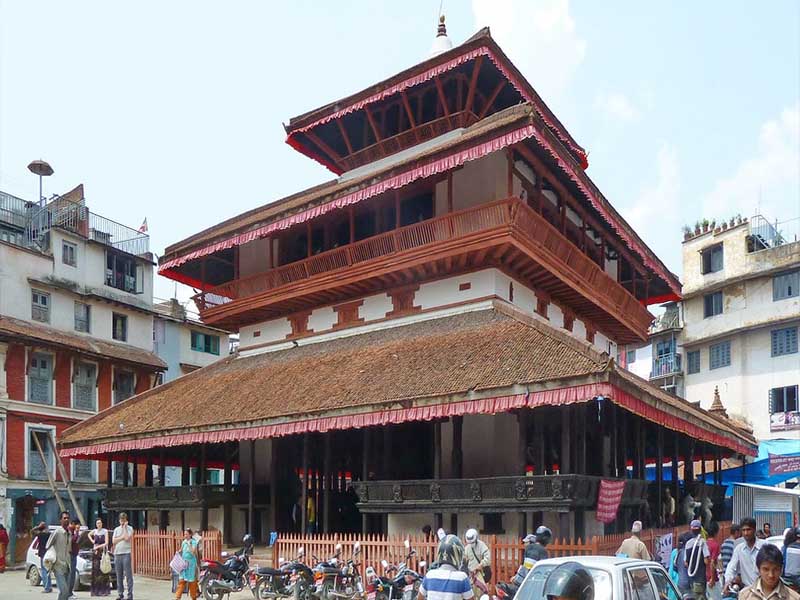
Kasthamandap Temple is located in Kathmandu Durbar Square, and its wood pavilion is one of the most important buildings in Nepal’s history. It is not a temple in the strict sense, despite the fact that the central space on the ground floor houses an image of Gorakhnath, a great preceptor of the Natha sect of Shaivism, which was quite popular in medieval Nepal.
The first floor features two panels that tell the story of the life of Buddha. Each story is surrounded by a balcony with a low railing, providing fabulous views of the city. Inside, the building is open, and the structure’s weight is carried by rows of massive decorated timber columns.
A popular story about the origin of this structure recounts that when the celestial tree, Kalpavrisksha, came to Earth in human form to witness the famous Matsyendranath festival, he was recognized by a Tantric adept, who begged him to build a monastery out of the wood of the celestial tree. The result is this pavilion made from the wood of a single tree.
The event is said to have happened during the reign of Lakshminrisimha Malla (1620-1639), and the building’s name, “Kasthamandapa,” is said to have given the city of Kathmandu its name. The pavilion is also considered the oldest-known wooden building in Nepal. It survived the 1934 earthquake and was renovated in 1966 but collapsed in the earthquake on April 25, 2015.
